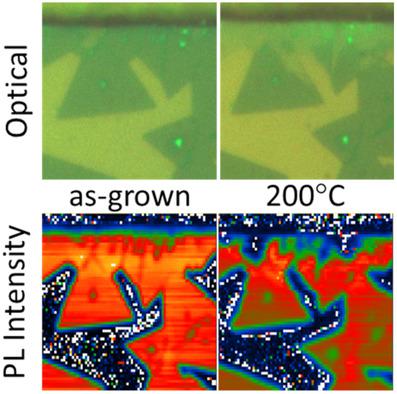当前位置:
X-MOL 学术
›
Phys. Status Solidi B
›
论文详情
Our official English website, www.x-mol.net, welcomes your feedback! (Note: you will need to create a separate account there.)
Thermal Annealing Effects on Naturally Contacted Monolayer MoS2
Physica Status Solidi (B) - Basic Solid State Physics ( IF 1.6 ) Pub Date : 2020-12-31 , DOI: 10.1002/pssb.202000426 Maryam Bizhani 1 , Ruhi Thorat 1 , William Poston 1 , Thushan Wickramasinghe 1 , Shrouq H. Aleithan 2 , Eric Stinaff 1
Physica Status Solidi (B) - Basic Solid State Physics ( IF 1.6 ) Pub Date : 2020-12-31 , DOI: 10.1002/pssb.202000426 Maryam Bizhani 1 , Ruhi Thorat 1 , William Poston 1 , Thushan Wickramasinghe 1 , Shrouq H. Aleithan 2 , Eric Stinaff 1
Affiliation

|
Transition metal dichalcogenides such as MoS2, which can be produced in monolayer form, have attracted attention because of their interesting and potentially useful electrical and optical properties. These properties often depend sensitively on material properties such as defect density and crystallinity. Herein, the effects of postgrowth annealing on monolayer MoS2 grown using a novel chemical vapor deposition process are investigated. In this process bulk molybdenum patterns serve as the nucleation site and source material for high-quality MoS2 material growth. After postgrowth thermal annealing, the photoluminescence is found to blueshift and become more uniform up to an annealing temperature of 300 °C. At higher temperatures, isolated monolayers begin to crack along the grain boundaries, which leads to variations in luminescence, whereas after annealing temperature of 200 °C, material anchored to the molybdenum patterns is found to easily ablate.
中文翻译:

自然接触单层二硫化钼的热退火效应
可以以单层形式生产的过渡金属二硫属化物如 MoS 2因其有趣且潜在有用的电学和光学性质而引起了人们的关注。这些特性通常敏感地取决于材料特性,例如缺陷密度和结晶度。在此,研究了生长后退火对使用新型化学气相沉积工艺生长的单层 MoS 2的影响。在此过程中,块状钼图案用作高质量 MoS 2的成核位点和源材料物质增长。在生长后热退火后,发现光致发光发生蓝移并在退火温度达到 300 °C 时变得更加均匀。在更高的温度下,孤立的单层开始沿晶界开裂,这导致发光的变化,而在 200 °C 的退火温度后,发现固定在钼图案上的材料很容易烧蚀。
更新日期:2020-12-31
中文翻译:

自然接触单层二硫化钼的热退火效应
可以以单层形式生产的过渡金属二硫属化物如 MoS 2因其有趣且潜在有用的电学和光学性质而引起了人们的关注。这些特性通常敏感地取决于材料特性,例如缺陷密度和结晶度。在此,研究了生长后退火对使用新型化学气相沉积工艺生长的单层 MoS 2的影响。在此过程中,块状钼图案用作高质量 MoS 2的成核位点和源材料物质增长。在生长后热退火后,发现光致发光发生蓝移并在退火温度达到 300 °C 时变得更加均匀。在更高的温度下,孤立的单层开始沿晶界开裂,这导致发光的变化,而在 200 °C 的退火温度后,发现固定在钼图案上的材料很容易烧蚀。


























 京公网安备 11010802027423号
京公网安备 11010802027423号